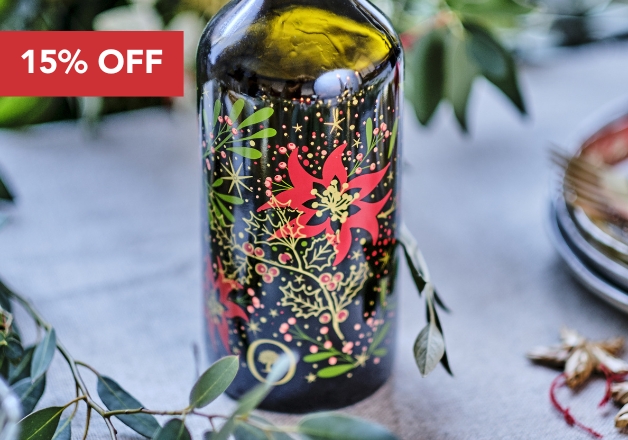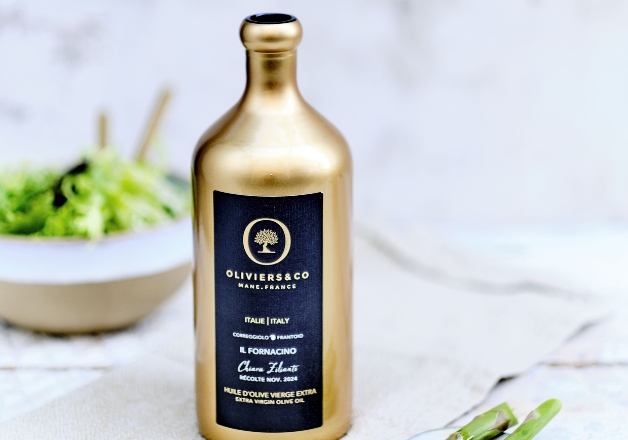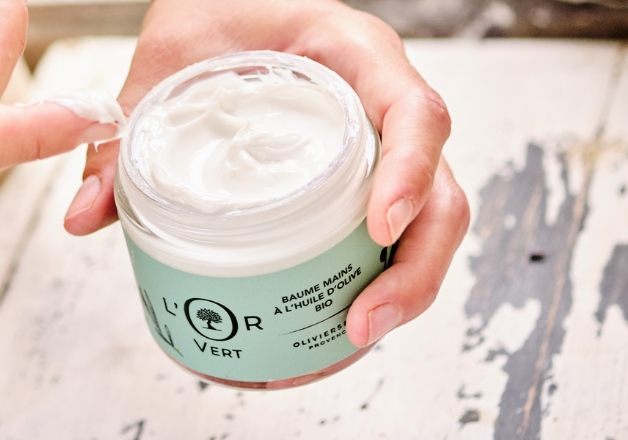HOW TO TASTE OLIVE OIL
HOW TO TASTE OLIVE OIL LIKE AN EXPERT
From Eric Verdier's Oliviers & Co laboratory, dedicated to sampling olive oils from the world's best producers, to our Oliviers&Co website, where we invite you to taste any oil, we have created this legend to guide your sensorial experience. It is a resource for both the olive oil lover who enjoys preferred taste profiles just as he (or she) might appreciate a great wine, to a newcomer to Oliviers&Co. It is to be used as a visual tool, an aid to breaking down the complexities of aromas, finishes and characteristics of olive oil tasting, just as the subtleties of tasting a fine wine. We share our knowledge in the hope of sharpening your palate and facilitating your olive oil selection process.
THE LIMITATION OF TASTE AND THE POWER OF AROMA
(like when you have a cold!)
The first step in learning to taste olive oil is to understand how our senses work. The perception of flavor relies on both our senses of taste and smell. The ability to taste is actually quite limited; the receptors on our tongue can only distinguish sweet, salt, sour, bitter and umami. All the other information we think of as flavour is actually perceived by smelling food through the back of our nostrils (retronasal) while it is in our mouth. Think about how little flavor we perceive when we have a cold - it's because we can't smell food retro-nasally when our nose is blocked.
THE TASTE PROFILE: TYPES OF OIL
Olive oil offers a palate rich in mouthful aromas, flavors and tastes. Some like it mellow, others fruity, bitter or lively, round or fiery, reflective of each terroir and its producer. Oliviers &Co believes that all olive oils qualified good tasting belong to one of the two taste profiles.
- Grassy oils: tend to be characterised by vegetal notes such as fresh grass, artichoke, tomato leaves or green apple.
- Floral oils: leave a soft and velvety impression of lightness, reminiscent of almond, milky, but also mixed with fruity notes of citrus, fruit, pear and hazelnut.
Red or white? Compared to the universe of wine, a "grassy" oil reacts like a young, aromatic, lively and warm wine, whereas a "floral" oil develops on the lines of round, silky and tender wines. In simpler terms, a grassy olive oil is more like a red wine while a floral oil is more like a white wine.
The Oliviers&Co Olive Oils collection: Each year, the harvest determines whether Oliviers&Co oils will be classified as grassy or floral. You will be able to find the taste profiles under each oil, with the capability to sort Olive Oils by one or the other taste profile: from intense grassy (very intense) to delicate floral (sweet).
THE NOSE
Worldwide, there are over 1000 varieties of olives grown, resulting in a wide range of flavor possibilities. We've extracted the following key to exemplify the most prevalent notes that underlie the characteristic profile and add distinction to each oil in the Oliviers&Co assortment.
 ALMOND: reminiscent of a toasted or bitter almond, nutty, fresh not oxidized
ALMOND: reminiscent of a toasted or bitter almond, nutty, fresh not oxidized ARTICHOKE: reminiscent of fresh artichoke, a green flavor
ARTICHOKE: reminiscent of fresh artichoke, a green flavor ASPARAGUS: reminiscent of fresh asparagus, expressive yet soft
ASPARAGUS: reminiscent of fresh asparagus, expressive yet soft BAKED APPLE: sweet/tart with hints of baking spices
BAKED APPLE: sweet/tart with hints of baking spices BANANA: ripe or unripe banana
BANANA: ripe or unripe banana BUTTER: warm notes of butter
BUTTER: warm notes of butter COCAO BEAN: full, rich, bold chocolate
COCAO BEAN: full, rich, bold chocolate![]() CUCUMBER: refreshing, watery, with a slightly bitter aftertaste
CUCUMBER: refreshing, watery, with a slightly bitter aftertaste CRÈME FRAICHE: fresh cream and slightly sour
CRÈME FRAICHE: fresh cream and slightly sour CYPRESS: crisp, fresh and earthy
CYPRESS: crisp, fresh and earthy DRIED HERBS: Light and more delicate herbs taste
DRIED HERBS: Light and more delicate herbs taste ENDIVE: has a slightly bitter flavor
ENDIVE: has a slightly bitter flavor FRESH CUT GRASS: aromas of freshly cut grass prevail
FRESH CUT GRASS: aromas of freshly cut grass prevail FRUITY: refers to the aroma of fresh olive fruit, which is perceived through the nostrils and retro-nasally when the oil is in one's mouth
FRUITY: refers to the aroma of fresh olive fruit, which is perceived through the nostrils and retro-nasally when the oil is in one's mouth GARRIGUE: notes of more pungent, floral fragrances
GARRIGUE: notes of more pungent, floral fragrances GREEN APPLE: green skinned granny smith with a tart taste
GREEN APPLE: green skinned granny smith with a tart taste GREEN PEPPER: mildly sweet flavor
GREEN PEPPER: mildly sweet flavor GREEN TEA: characteristic of some unripe olive varieties
GREEN TEA: characteristic of some unripe olive varieties![]() GREEN TOMATO: bright, sour-sweet flavor
GREEN TOMATO: bright, sour-sweet flavor HAZELNUT: amazingly broad, from smoky and toasty all the way to fruity
HAZELNUT: amazingly broad, from smoky and toasty all the way to fruity LEMON: bright, tart / sour like a lemon
LEMON: bright, tart / sour like a lemon MELON: fragrance of a ripe melon
MELON: fragrance of a ripe melon MISMOSA FLOWER: sweet floral notes
MISMOSA FLOWER: sweet floral notes MUSTARD SEEDS: sharp, tangy mustard flavor with a little bite of spice
MUSTARD SEEDS: sharp, tangy mustard flavor with a little bite of spice OLIVE TREE / LEAF: light tasting
OLIVE TREE / LEAF: light tasting PEAR: crisp, semi sweet taste
PEAR: crisp, semi sweet taste PINE: earthy, crisp, fresh
PINE: earthy, crisp, fresh PINEAPPLE: very sweet, juicy and tropical
PINEAPPLE: very sweet, juicy and tropical![]() PINE NUTS: mildly sweet, nutty flavor with a hint of pine
PINE NUTS: mildly sweet, nutty flavor with a hint of pine SEA SPRAY: slightly salty, bright
SEA SPRAY: slightly salty, bright SEAWEED: a tangy savory & salty taste
SEAWEED: a tangy savory & salty taste TOMATO: tomato or like the leaf of a tomato
TOMATO: tomato or like the leaf of a tomato OLIVE TREE FLOWERS: Subtle feathery notes of tiny flowers
OLIVE TREE FLOWERS: Subtle feathery notes of tiny flowers DRIED GRASS: Hints of dried grass
DRIED GRASS: Hints of dried grass WHITE PEPPER: bright, warm peppery spice
WHITE PEPPER: bright, warm peppery spice WHITE TEA: gentile, and crisp tea, with a slightly floral taste
WHITE TEA: gentile, and crisp tea, with a slightly floral taste
THE PALATE
When tasting an olive oil, the steps focus our attention on a specific positive attribute of the oil. After assessing the fruit aroma by inhaling from a glass, when the oil is in our mouth, we further evaluate the retro-nasal aroma and determine the amount of bitterness on our tongues. Finally, we determine the intensity of the oil's pungency in our throats as we swallow it.
Here are a series of definitions we use to further classify oils in the palate flavour profile. We feel it is important to contextualise the palate by suggesting food pairings and oil use to further help you in selecting the perfect oil for all your cooking preferences. As a general rule, you will find that our recommendations stem from the finish in terms of mild, medium and robust.
- Mild olive oils:
These tend to be buttery, mellow, delicate and light; these pair well with light or delicate dishes such as fish, soups, vegetables, pesto, eggs and potatoes. - Medium olive oils :
Slightly more robust, they generally have a more herbaceous and complex flavour profile. These oils have a peppery finish and are excellent with steak, bruschetta, tomato sauces, pasta and any dish where you want to cut through and brighten up the flavours already present. - Robust and powerful olive oils:
Robust oils, made from olives picked when they are mostly green, tend to have a more assertive, peppery flavor, usually with notes of green vine tomatoes, green tomato leaf and green apple skin.
Full-flavored, more robust dishes made with red meat and tomato-based sauces, as well as a hearty stew, even steamed vegetables and salads, may be better with these fruitier, more flavorful oils.
Palate terms:
BITTER: considered a positive attribute as it indicates fresh olives
BUTTERY: smooth and creamy mouth feel
FRESH: good aroma, fruity, not oxidised
HARMONIOUS: balance between the oil's characteristics without any one dominating the others
PEPPERY: a stinging sensation in the throat, which can force a cough
ROUND: a balanced and nourishing sensation of harmonious flavours
SPICY: aroma/flavour of seasonings such as cinnamon, allspice





























